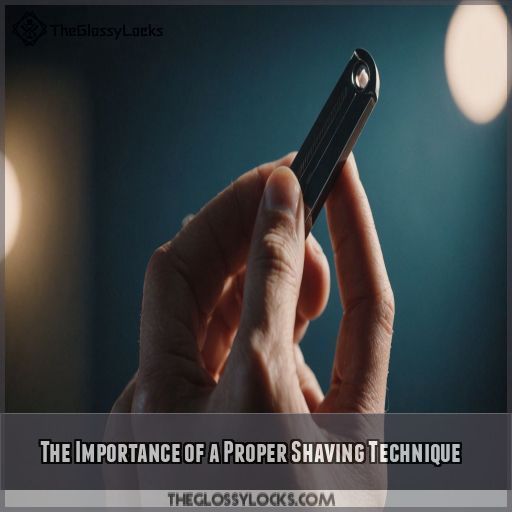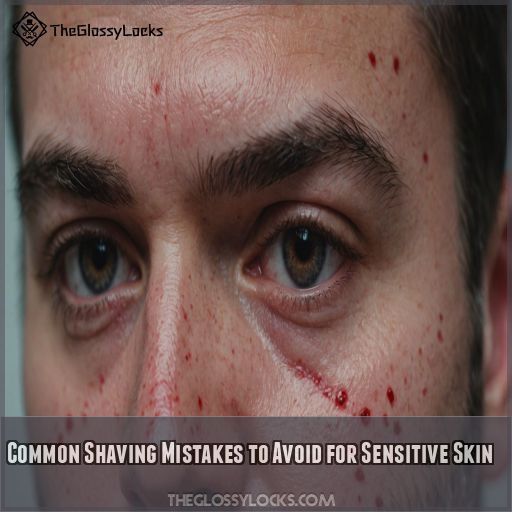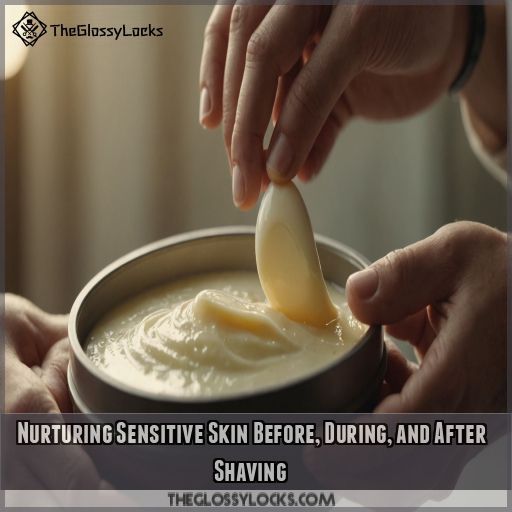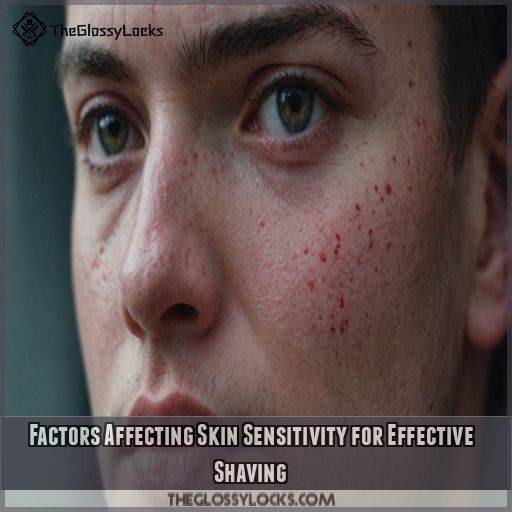This site is supported by our readers. We may earn a commission, at no cost to you, if you purchase through links.
 Shaving with sensitive skin can be a real challenge! You’re not alone – many of us struggle to find the right balance between a smooth shave and irritation-free skin.
Shaving with sensitive skin can be a real challenge! You’re not alone – many of us struggle to find the right balance between a smooth shave and irritation-free skin.
To start, focus on preparing your skin with warm water and gentle exfoliation.
Then, choose the right tools, like a safety razor and fragrance-free shaving cream.
Mastering a gentle shaving technique, such as clipping with the grain, is key.
- Shave with the grain.
- Use lukewarm water.
- Don’t apply too much pressure.
Table Of Contents
- Key Takeaways
- Preparing for a Comfortable Shave
- Selecting the Right Tools for Sensitive Skin
- The Importance of a Proper Shaving Technique
- Common Shaving Mistakes to Avoid for Sensitive Skin
- Nurturing Sensitive Skin Before, During, and After Shaving
- Factors Affecting Skin Sensitivity for Effective Shaving
- Frequently Asked Questions (FAQs)
- What is the best shaving option for sensitive skin?
- Is it better to shave wet or dry for sensitive skin?
- What is the least irritating way to shave?
- How do you avoid possible sensitivity while shaving?
- Can certain dietary changes help improve sensitive skin conditions?
- Are there any specific exercises or facial massages for skin sensitivity?
- How does the weather or environment affect shaving for sensitive skin?
- Can certain medications influence skin sensitivity when shaving?
- Is there a difference in shaving sensitive skin for men and women?
- Conclusion
Key Takeaways
- You’re not alone in the struggle to find a smooth shave with sensitive skin, but with the right preparation and technique, you can achieve an irritation-free shave that’ll make you feel like you’re walking on sunshine.
, but with the right preparation, tools, and technique, you can achieve an irritation-free shave that’ll make you feel like you’re walking on sunshine.
- Exfoliating one to two times a week with a gentle scrub can be a total game-changer for reducing ingrown hairs and skin irritation, so don’t be afraid to get a little scrubby before you shave.
- Ditch that multi-blade razor and opt for a safety razor with a single-blade design, paired with a soothing shaving cream and a gentle shaving brush – your sensitive skin will thank you for the extra TLC.
- Shaving with the grain, using lukewarm water, and avoiding too much pressure are the holy trinity of shaving techniques for sensitive skin – master these and you’ll be well on your way to a smooth, comfortable shave that’ll leave you feeling like a total boss.
Preparing for a Comfortable Shave
When you have sensitive skin, shaving can be a tricky task, but with the right preparation, you can achieve a smooth, irritation-free shave. To start, let’s explore the simple yet effective steps you can take before shaving to make sure your skin is ready for a comfortable and stress-free experience.
Soaking in Warm Water Before Shaving
Soaking in warm water before shaving is like giving your skin a big hug – it’s all about comfort and preparation. Warm water increases skin hydration, opens up your pores, and softens your hair, making it easier to shave. This simple step can make all the difference in reducing razor burn and irritation, especially for sensitive skin.
Exfoliating Beforehand to Prevent Ingrown Hairs
The pesky ingrown hairs! Exfoliating beforehand can be a game-changer. By removing dead skin cells after microneedling isn’t mentioned here, instead I used, you’ll reduce the risk of ingrown hairs and skin irritation
, you’ll reduce the risk of ingrown hairs and skin irritation. Here are some tips:
- Exfoliate 1-2 times a week to Maintain Healthy Skin naturally by removing dead skin cells.
.
- Choose a gentle scrub that won’t strip your skin of its natural oils.
- Focus on areas prone to ingrown hairs.
- Be gentle, don’t over-exfoliate and irritate your skin.
Choosing the Right Shaving Cream for Sensitive Skin
For sensitive skin, choosing the right shaving cream can be a total game-changer. Opt for fragrance-free, hypoallergenic options infused with soothing ingredients like aloe vera. These creams will help protect your skin from irritation and ingrown hairs. Look for natural oils and avoid harsh chemicals to keep your skin calm and comfortable.
Selecting the Right Tools for Sensitive Skin
For shaving with sensitive skin, the tools you use can make all the difference. By choosing the right razor and shaving brush, you can minimize irritation and achieve a smooth, comfortable shave that leaves your skin feeling healthy and happy.
Opting for a Safety Razor With a Single-Blade Design
Time to trade in that multi-blade razor for a safety razor with a single-blade design! This simple switch can really cut down on irritation. Here’s why:
- Fewer blades, less friction: One blade means less rubbing against your skin.
- Sharper blade, smoother shave: A sharp single blade glides more easily, reducing nicks and cuts.
- Better control: A safety razor allows for more precise shaving.
- Less razor burn: Say goodbye to those pesky red bumps!
Characteristics of a Good Shaving Brush for Sensitive Skin
Now that you’ve opted for a safety razor, let’s talk about the perfect sidekick: a shaving brush. For sensitive skin, look for a brush with soft bristles that won’t scratch or irritate. Here’s a handy guide to help you choose:
| Brush Characteristic | What to Look for |
|---|---|
| Bristle Softness | Gentle, flexible bristles |
| Brush Handle | Ergonomic, non-slip design |
| Brush Size | Compact, easy to maneuver |
| Bristle Density | Dense, yet gentle on skin |
| Cleaning Routine | Easy to clean, dry, and maintain |
The Importance of a Proper Shaving Technique
You’re about to learn the secret to a smooth, irritation-free shave – and it all starts with mastering the right technique. By shaving with the grain and using lukewarm water, you’ll be well on your way to taming your sensitive skin and achieving that coveted close shave without the dreaded razor burn.
Shaving With the Grain to Prevent Irritation
You’ve got the right tools, now it’s time to master the technique!
Shaving with the grain is key to preventing irritation.
Pay attention to your hair growth patterns and adjust your razor angle accordingly.
.
Maintain a sharp blade and prep your skin with a soothing cream.
Think of it like petting a cat – go with the flow, not against it!
Using Lukewarm Water for Shaving to Minimize Redness
When you’re shaving with sensitive skin, water temperature matters. Here are three reasons to use lukewarm water:
- Reduces skin reactions: Hot water can strip your skin of its natural oils, leading to irritation.
- Prevents pores from closing: Cold water can cause pores to close, making it harder for the razor to glide smoothly.
- Soothes and calms: Lukewarm water helps to calm and comfort your skin, reducing redness and inflammation.
Common Shaving Mistakes to Avoid for Sensitive Skin
As you master the art of shaving with sensitive skin, As you master the art of shaving with sensitive skin, you need to identify the common mistakes that can sabotage your progress, much like avoiding hair extension mistakes.
. By avoiding simple slip-ups, such as using a dirty razor or applying too much pressure, you can reduce irritation and enjoy a smoother, more comfortable shave.
Not Using a Clean Razor to Prevent Bacterial Buildup
If you have sensitive skin, a clean razor is key. Failing to clean your razor regularly can lead to bacterial buildup, causing skin infections, razor bumps, and ingrown hairs. Don’t let your razor become a petri dish!
| Razor Hygiene | Consequences of Poor Hygiene |
|---|---|
| Clean razor after each use | Bacteria growth and skin infections |
| Store razor in dry place | Razor bumps and ingrown hairs |
| Replace razor regularly | Reduced risk of skin irritation |
Applying Too Much Pressure During Shaving to Minimize Discomfort
When shaving, it’s easy to apply too much pressure, trying to get that perfect glide. But, for sensitive skin, that’s a recipe for disaster. Instead, focus on finding the right razor angle and blade sharpness. Let the weight of the razor do the work, and use light, gentle strokes to maintain control and minimize skin tension.
Nurturing Sensitive Skin Before, During, and After Shaving
When you have sensitive skin, a smooth shave can feel like a miracle – but it’s totally achievable with the right approach. By taking care to nurture your skin before, during, and after shaving, you can minimize irritation and enjoy a healthy, comfortable glow that lasts long after you put down your razor.
Cleansing With Gentle, Hypoallergenic Soap or Cream Before Shaving
Before you even pick up that razor, let’s get your skin ready for a smooth shave. Start with a gentle, hypoallergenic soap or cream that’ll treat your skin with kindness. Here’s what to look for:
- pH-balanced to match your skin’s natural acidity
- Free from harsh chemicals and fragrances
- Soothing ingredients like aloe vera or chamomile
- Non-comedogenic to prevent clogged pores
Hydrating Sensitive Skin to Maintain Optimal Health and Wellness
Now that you’ve cleansed your skin, it’s time to lock in moisture.
Hydrating sensitive skin is key to maintaining ideal health and wellness.
Use a gentle, pH-balanced moisturizer with humectant benefits, like hyaluronic acid or ceramides, to retain moisture.
Apply it twice a day, and consider natural hydrators like aloe vera or coconut oil to keep your skin soothed and supple.
Factors Affecting Skin Sensitivity for Effective Shaving
Shaving with sensitive skin requires thinking about the underlying factors that affect your skin’s sensitivity. By understanding how genetic skin conditions, environmental irritation factors, and lifestyle choices impact your skin, you can tailor your shaving routine to minimize irritation and achieve a smooth, comfortable shave.
Genetic Skin Conditions
Genetic skin conditions like eczema, psoriasis, and rosacea can make shaving a sensitive skin nightmare. If you’re prone to these conditions, you know how frustrating it can be. Consider skin allergy testing to identify triggers, and explore treatment options like atopic dermatitis care to keep your skin healthy and resilient. This will make shaving a whole lot easier (Source).
Environmental Irritation Factors
When it comes to environmental irritation factors, you’re not just fighting your skin – you’re also up against the elements. Air pollution, harsh weather, and sun exposure can weaken your skin, while poor water quality and chemical exposure can strip it of its natural oils. Be gentle, and take steps to shield your skin from these everyday stressors.
Lifestyle Choice Impacts
Your lifestyle choices can either soothe or sabotage your sensitive skin.
Stress, for instance, can trigger inflammation.
A balanced diet rich in omega-3s and antioxidants can calm it down.
Regular exercise, adequate sleep, and a consistent skincare routine can also help.
Frequently Asked Questions (FAQs)
What is the best shaving option for sensitive skin?
Did you know 70% of men experience shaving irritation? For sensitive skin, ditch multi-blade razors and opt for a safety razor with a single-blade design, paired with a soothing shaving cream and a gentle shaving brush.
Is it better to shave wet or dry for sensitive skin?
For sensitive skin, shaving wet is the way to go! A warm shower or hot towel softens your beard and opens pores, making it easier to glide the razor and reduce irritation.
What is the least irritating way to shave?
Did you know 70% of men experience shaving irritation? To minimize yours, try a safety razor with a single-blade design, shaving cream specifically formulated for sensitive skin, and a soothing aftershave with aloe and hyaluronic acid.
How do you avoid possible sensitivity while shaving?
To avoid sensitivity while shaving, prep your skin with a warm shower or hot towel, use a sharp razor and shaving cream specifically designed for sensitive skin, and shave with the grain (Source).
Can certain dietary changes help improve sensitive skin conditions?
Want to tame the sensitivity beast from the inside out? While there’s no magic bullet, research suggests that a diet rich in omega-3 fatty acids, antioxidants, and fiber may help reduce inflammation and improve sensitive skin conditions.
Are there any specific exercises or facial massages for skin sensitivity?
You can try facial yoga or gentle massage techniques to reduce skin sensitivity. These exercises can improve blood flow, relax facial muscles, and even help reduce inflammation – just be gentle, your skin will thank you!
How does the weather or environment affect shaving for sensitive skin?
Batten down the hatches! Weather and environment can wreak havoc on sensitive skin. Extreme temperatures, humidity, and dry air can strip your skin of its natural oils, making shaving a recipe for disaster, so adjust your routine accordingly.
Can certain medications influence skin sensitivity when shaving?
When shaving, certain medications can indeed impact your skin’s sensitivity. Topical treatments, hormonal influences, and your immune response can trigger sensitivity, so always check your medication’s side effects carefully (Source).
Is there a difference in shaving sensitive skin for men and women?
In terms of shaving sensitive skin, men and women have different needs. Men’s skin tends to be thicker and drier, while women’s skin is more prone to irritation due to hormonal fluctuations.
Conclusion
Imagine the soft glow of a warm light on your skin, symbolizing the gentle care it craves.
As you master the art of shaving tips for sensitive skin care, you’ll find that a smooth, irritation-free shave is within reach.
By choosing the right tools, perfecting your technique, and being mindful of your skin’s unique needs, you’ll be on your way to a more comfortable shaving experience.
With practice, patience, and the right approach, shaving tips for sensitive skin care will become your trusted ally.









